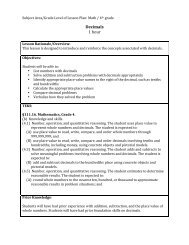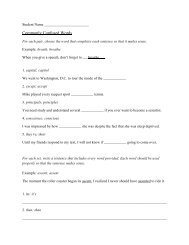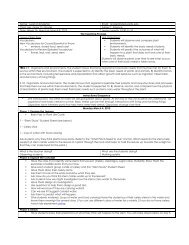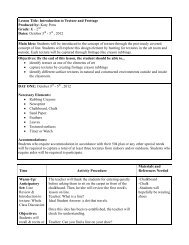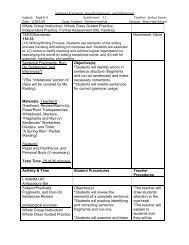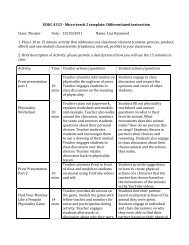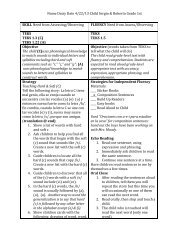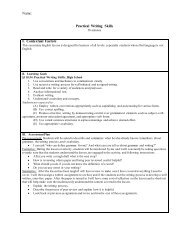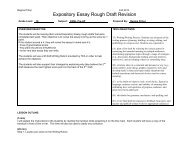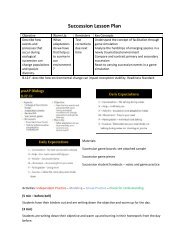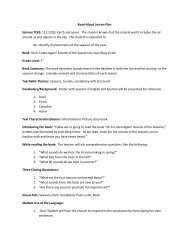My Philosophy about Education - St. Edwards University
My Philosophy about Education - St. Edwards University
My Philosophy about Education - St. Edwards University
You also want an ePaper? Increase the reach of your titles
YUMPU automatically turns print PDFs into web optimized ePapers that Google loves.
Ashley DenningtonEDUC 2331.02Dr. David HollierSeptember 4, 2011<strong>Philosophy</strong> of Learning: Report 1“This I Believe…”I believe that learning is a very special journey taken by both students andteachers that should be fun. Learning frequently involves effort, whether voluntary andconscious or involuntary and unconscious. Teachers must learn <strong>about</strong> his or herstudents and their needs, learning styles, and strong points. They should also learn howto effectively motivate and inspire students. Learning requires a safe and comfortableenvironment that is nurturing and welcoming of any and all questions. I believe thatlearning does not have limits either, and should frequently lead to more questions. I feelthat learning is a never ending adventure.When I teach, I want to make learning accessible and desirable for my students. Ithink it is important to learn what inspires students, and then teach using such interest.Art and design are very interesting to me, and I think integrating these into a normalclassroom setting would give me satisfaction. I would feel more motivated as a teacher,and probably put forth more effort and passion towards the subject. Take the wordfundamental – the first syllable is fun – something that I believe goes hand in hand withlearning. I have twin sisters who are three and a half years younger than I. We would
play school more than any other game, and I was usually the teacher. Everything Ilearned I would teach my sisters. They were able to read, count to high numbers, andspell before any of their pre-school peers. We were able to play and have fun whilelearning. To this day, they have remained at the top of their grade. Making learning afun and rewarding task has shown me firsthand how effective simply involving thestudents and making them want to learn can be.Some students may be shy or remain uninterested, but there is something thateveryone enjoys. I have been working with one student for five years now. When wefirst started working together, she wouldn’t even talk to me. She would alienate herselffrom the rest of her class, and when I would tutor her, she would be uninterested andunmotivated. She was failing more classes than not, and her parents were concerned.So, I started attaching outside motivation to her schoolwork. I observed how much sheloved animals, as in her assignment notebook were drawings of dogs as opposed to herdaily assignments. As I intend to teach art, this was exciting to me. Our next meeting, Ibrought my sketchbook and pictures of my dog. I cracked her shell-finally we had aconversation that didn’t consist of three words! By the end of that day, she waslaughing, smiling, and interested. We invented a character: basset hound genius JakeEinstein. We would take turns with her readings using Jake Einstein’s deep, raspyvoice and she became interested in the stories. Her ability to recall and answerquestions <strong>about</strong> her readings excelled. I taught her to use Jake Einstein’s voice in herhead to repeat things that her teacher would say in class, and to think of all of herassignments with him in mind. After all of her assignments are complete, she receivesdrawing lessons, focusing primarily on cartoon drawing and dogs. This tool helped so
much with this student. Thinking outside of the box and integrating a student’s interestsand desires into a lesson or tutoring session and using outer motivations such as arthave proven effective. If I can use this strategy in a classroom setting as opposed totutoring one on one, I think I will be a much more successful teacher.



